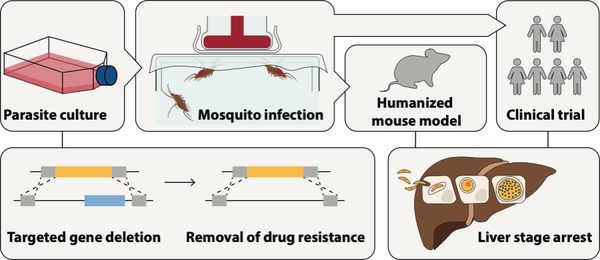Genetically Attenuated Parasites (GAPs) in Malaria Vaccine Development
Prof. Dr. Kai Matuschewski
The concept of genetically attenuated parasites (GAPs) as malaria vaccines emerged from efforts to mimic the natural immunity observed in individuals exposed to attenuated Plasmodium parasites. In the late 1960s, Ruth Nussenzweig and Jerry Vanderberg at New York University demonstrated that irradiated sporozoites could confer sterile immunity in animal models, laying the groundwork for parasite-based vaccine approaches. However, irradiation lacks precision and can produce inconsistent attenuation.
Plasmodium reverse genetics enabled researchers to create targeted gene deletions in the haploid unicellular parasite. The systematic identification of Plasmodium genes, which are upregulated only in parasites transmitted during the bite by an infected Anopheles mosquito [1] paved the way for generation of Plasmodium parasites with targeted deletions of genes crucial for liver-stage development. These GAPs halt in the liver, preventing progression to the blood stage while stimulating a strong immune response. The first successful GAPs were developed in Plasmodium berghei (a murine malaria model) by deleting the genes UIS3 and UIS4 [2,3].

Development of genetically attenuated parasites (GAPs) [from Ref. 4]
Subsequent efforts focused on multiple gene deletions [5], deletion of the liver stage master regulator SLARP [6], and generation of late-arrested GAPs [7], which consistently displays superior immunity. Extended liver-stage antigen exposure is hypothesized to enhance protective immunity compared to early-arresting parasite lines.
Compared to irradiated sporozoites, GAPs provide more reliable attenuation through precise genetic modifications. Most recent advancements include late-liver stage arrested Plasmodium falciparum GAPs, which showed promising protection against sporozoite challenge infection in small-scale phase I/IIa trials [reviewed in Ref. 4]. If efficacy is confirmed in larger clinical trials in malaria-endemic countries, GAP-based vaccines could transform malaria control efforts, offering a potent tool for global eradication initiatives.
Together, this field continues to evolve, integrating genetic engineering, immunology, and vaccine science to combat one of humanity's most persistent and deadly diseases.
References:
[1] Matuschewski K, Ross J, Brown S, Kaiser K, Nussenzweig V, Kappe SHI (2002) Infectivity-associated changes in the transcriptional repertoire of the malaria parasite sporozoite stage. J. Biol. Chem. 277: 41948-41953. doi: 10.1074/jbc.M207315200
[2] Mueller AK, Labaied M, Kappe SHI, Matuschewski K (2005) Genetically modified Plasmodium parasites as a protective experimental malaria vaccine. Nature 433: 164-167. doi: 10.1038/nature03188
[3] Mueller AK, Camargo N, Kaiser K, Andorfer C, Frevert U, Matuschewski K, Kappe SHI (2005) Plasmodium liver stage developmental arrest by depletion of a protein at the parasite-host interface. Proc. Natl. Acad. Sci. USA 102: 3022-3027. doi: 10.1073/pnas.0408442102
[4] Hafalla JCR, Borrmann S, Matuschewski K (2025) Genetically attenuated parasite shows promise as a next-generation malaria vaccine. Trends Parasitol., in press.
[5] Jobe O, Lumsden J, Mueller AK, Williams J, Silva-Rivera H, Kappe SHI, Schwenk RJ, Matuschewski K, Krzych U (2007) Genetically-attenuated Plasmodium berghei liver-stages induce sterile protracted protection that is mediated by MHC class I-dependent IFN-γ producing CD8+ T cells. J. Infect. Dis. 196: 599-607. doi: 10.1086/519743
[6] Silvie O, Goetz K, Matuschewski K (2008) A sporozoite asparagine-rich protein controls initiation of Plasmodium liver stage development. PLoS Pathog. 4: e1000086. doi: 10.1371/journal.ppat.1000086
[7] Haussig J, Matuschewski K, Kooij TWA (2011) Inactivation of a Plasmodium apicoplast protein attenuates formation of liver merozoites. Mol. Microbiol. 81: 1511-1525. doi: 10.1111/j.1365-2958.2011.07787.x
Further Reading:
Borrmann S, Matuschewski K (2011) Targeting Plasmodium liver stages: better late than never. Trends Mol Med. 17: 527-536. doi: 10.1016/j.molmed.2011.05.008
Kreutzfeld O, Müller K, Matuschewski K (2017) Engineering of genetically arrested parasites (GAPs) for a precision malaria vaccine. Front. Cell. Infect. Microbiol. 7: 198. doi: 10.3389/fcimb.2017.00198
Matuschewski K, Hafalla JC, Borrmann S, Friesen J (2011) Arrested Plasmodium liver stages as experimental anti-malaria vaccines. Hum. Vacc. 7 (Suppl.): 16-21. doi: 10.4161/hv.7.0.14557
Matuschewski K (2007) Hitting malaria before it hurts: attenuated Plasmodium liver stages. Cell. Mol. Life Sci. 64: 3007-3011. doi: 10.1007/s00018-007-7263-z
Matuschewski K (2017) Vaccines against malaria – still a long way to go. FEBS J. 284: 2560-2568. doi: 10.1111/febs.14107